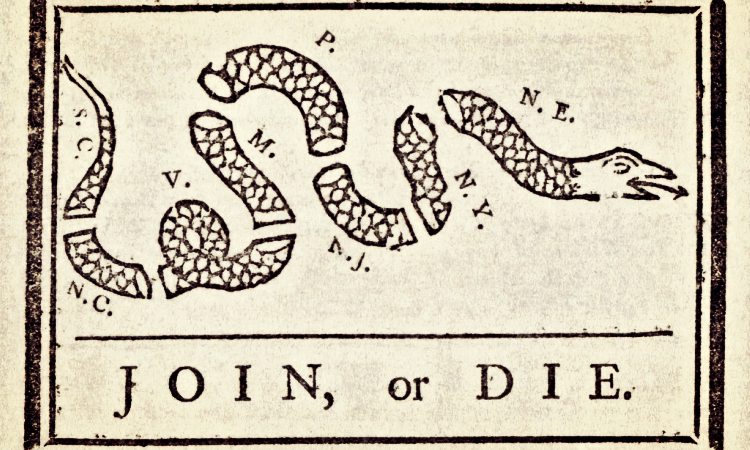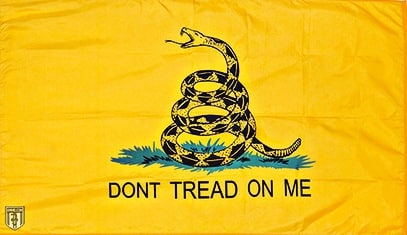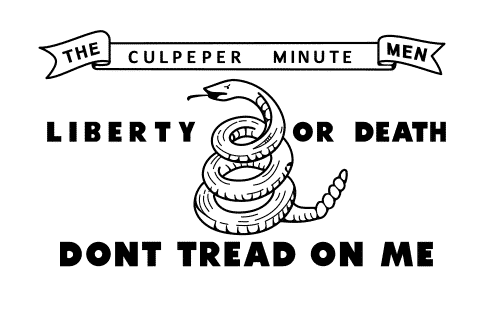 DON’T TREAD ON ME – The meaning and history behind the Gadsden Flag.
DON’T TREAD ON ME – The meaning and history behind the Gadsden Flag.
A survivalist’s mindset includes a hefty dose of self-reliance.
And self-reliance is an attitude of fierce independence.
It’s the idea of never relying on other people’s handouts and freebies.
Instead, build on your survival skills, knowledge, and hard work to thrive.
It’s a philosophy of reaping what you sow without interference – without government control or tyranny.
And we need this philosophy of fierce independence now more than ever.
Why?
Because tyranny is rising, and government control is not going away.
I wish this weren’t true, but the sad fact is, it’s coming….like it or not.
Our current internet era mirrors the period following the printing press’s invention.
When monarchies were forced to increase tyranny in an attempt to maintain control…
Why Rising Tyranny Is Inevitable (Like It Or Not)
Many of us adopt the idea of self-reliance on a personal level, but it can also be adopted national level as well.
The United States was founded on this idea of fierce self-reliance.
And we know this in part because of the symbols used before, during, and after the formation of the United States of America.
Old symbols were used before the stars and stripes flew over this great land.
The ones adopted before Old Glory became the official flag of the union.
These were the symbols and flags that captured the true spirit of the American colonies.
Representing the essence of the struggle for independence from British rule’s tyranny.
So today, we’ll discuss one symbolic message – Don’t Tread On Me – and one flag in particular: The Gadsden Flag.
We’ll cover in detail what this flag is, what it represents, how it came to be, and how it’s used today.
Are You Ready For The Tough Times Ahead? Take My 60 Sec Quiz To See If You’re Part Of ‘The Fragile Masses’ Or Not… Start Quiz Now!
The Rattlesnake
The following video covers everything that’s in the remaining article, so I recommend you watch this video.
However, if you don’t like videos or can’t watch them, continue reading about the Gadsden Flag.
The Origins Of The Gadsden Flag
Many find it surprising that a rattlesnake was the symbol used by the early colonies. What does a rattlesnake have to do with America and American ideals?
Aside from it being indigenous to the original 13 colonies, more than you think…
In 1754 Benjamin Franklin printed the first political cartoon in an American newspaper.
The cartoon depicts a rattlesnake cut up into eight separate pieces.
Each section represents the initial eight colonies, with New England at the head and South Carolina at the tail.
Below, this image includes the words “Join or Die.”
This was a public call for the unification of the colonies years before the Revolution.
The symbol was used again to call for unification against the tyranny of British rule.
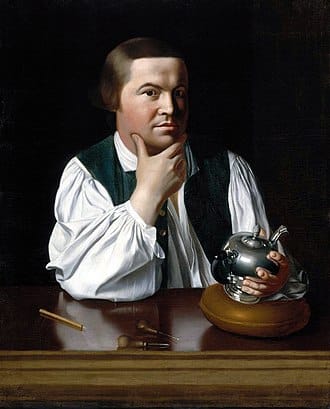
Paul Revere
In 1774, a year before the Revolution began, Paul Revere adopted Franklin’s cartoon. He used it in the nameplate of his newspaper, the Massachusetts Spy.
This symbolism represented the colonies as fractured entities. Ones must come together to unite against tyranny or die.
While the symbol of a healthy, whole, and deadly rattlesnake ready to strike soon became the new colonial symbol.
What is The Gadsden Flag? Explained
The Gadsden Flag
One of the most common of these early rattlesnake flags was The Gadsden Flag.
The Gadsden Flag depicts a coiled rattlesnake – ready to strike – on a background of yellow.
It also includes the words: Don’t Tread On Me in bold letters below the image.
Benjamin Fraklin’s Contribution
No discussion of the American Revolution is complete without bringing Benjamin Franklin into the conversation.

Benjamin Franklin
Benjamin Franklin was not one to mince words or sugar-coat anything. For example, he once described the rattlesnake as the perfect symbol of our new national character:
“ …it occurred to me that the Rattle-Snake is found in no other quarter of the world besides America, and may, therefore, have been chosen, on that account, to represent her.
But then “the worldly properties” of a Snake I judged would be hard to point out. This rather raised than suppressed my curiosity, and having frequently seen the Rattle-Snake, I ran over in my mind every property by which she was distinguished, not only from other animals but from those of the same genus or class of animals, endeavoring to fix some meaning to each, not wholly inconsistent with common sense.
I recollected that her eye excelled in brightness, that of any other animal, and that she has no eye-lids. She may therefore be esteemed an emblem of vigilance. She never begins an attack, nor, when once engaged, ever surrenders: She is therefore an emblem of magnanimity and true courage. As if anxious to prevent all pretensions of quarreling with her, the weapons with which nature has furnished her, she conceals in the roof of her mouth, so that, to those who are unacquainted with her, she appears to be a most defenseless animal; and even when those weapons are shown and extended for her defense, they appear weak and contemptible; but their wounds however small, are decisive and fatal. Conscious of this, she never wounds ’till she has generously given notice, even to her enemy, and cautioned him against the danger of treading on her.
Was I wrong, Sir, in thinking this a strong picture of the temper and conduct of America? The poison of her teeth is the necessary means of digesting her food, and at the same time is certain destruction to her enemies. This may be understood to intimate that those things which are destructive to our enemies, may be to us not only harmless, but absolutely necessary to our existence. I confess I was wholly at a loss what to make of the rattles, ’till I went back and counted them and found them just thirteen, exactly the number of the Colonies united in America”
The image of the rattlesnake before the bald eagle symbolized the early colonies. It came to symbolize extreme vigilance. To be defensive by default but poised to strike quickly with lethality when threatened.
Other Variations Of The Gadsden Flag
There were many flags in that area with the rattlesnake theme. Even some wording variations, such as – Join or Die or Don’t Tread on Me.
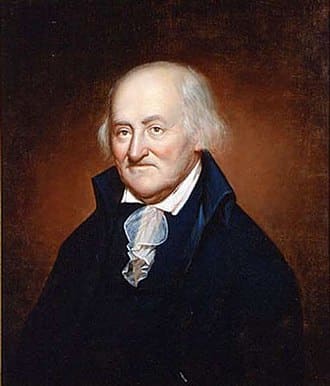
Christopher Gadsden
A South Carolina politician, Christopher Gadsden, gets credit with the first official Gadsen Flag design. But, the evolution of the Gadsden flag followed many paths.
In 1775 the Second Continental Congress authorized the mustering of 5 companies of Marines. These Marines were to go with the Colonial Navy on their first mission.
These first Marines in the city of Philadelphia carried drums. These drums were yellow with a coiled rattlesnake with thirteen rattles.
It also included the motto “Don’t Tread on Me.”
This is the first recorded mention of the future Gadsden flag’s symbolism.
Colonel Gadsden was one of seven members of the Marine Committee whose first departure was December 1775.
On this departure, the commander-in-chief of the Navy, Commodore Esek Hopkins, received the yellow rattlesnake flag from Colonel Gadsden.
This design was to serve as the distinctive personal standard of his flagship. It was displayed at the mainmast, and this was the first appearance of the true Gadsden Flag.
Commodore Hopkins was very familiar with the rattlesnake symbolism.
The 1775 flag featured a coiled timber rattlesnake and the motto “Do Not Tread on Me.” Along with an anchor, cannons, and the motto “In God, We Hope” on a gold background.
Gadsden’s flag, presented to the Commander of the Continental Navy, is a simplified version of that design.
Gadsden also presented a copy of this flag to the Congress of South Carolina in Charleston. This was recorded in the South Carolina congressional journals on February 9, 1776:
Colonel Gadsden presented to the Congress an elegant standard, such as is to be used by the commander in chief of the American Navy, being a yellow field, with a lively representation of a rattlesnake in the middle in the attitude of going to strike and these words underneath, Don’t Tread On Me.
The Culpeper Minute Men
Other variations on rattlesnake-themed flags include the flag used by the Culpepper Minutemen. It had a coiled rattlesnake and the same motto as the Gadsden flag.
It has a white field, rather than yellow, and the added motto “Liberty or Death” and the name “The Culpeper Minute Men.”
It’s the flag of Virginia volunteers from the Culpeper area.
The rattlesnake symbol itself was also approved for the official Seal of the War Office.
Which was the Headquarters of the Army, by the Continental Congress in 1778. At the top center of the Seal is a rattlesnake holding a banner that says: “This We’ll Defend.”
This signifies the Army’s constant readiness to defend and preserve the Nation. This design of the War Office Seal was carried forward with some minor modifications.
It also had later designs for the War Department’s Seal and the Department of the Army’s Seal, Emblem, and Flag.
As such, the rattlesnake symbol has been in continuous official use by the US Army for over 236 years.
The Flags Resurgence
Aside from the rattlesnake for the Revolution, the Gadsden flag has resurged. It’s become a symbol of American patriotism. It’s a way to signal disagreement with government control and support civil liberties.
The imagery of the deadly rattlesnake, defensive yet coiled, is powerful even today. It’s been adopted by many groups throughout the years. Most of these groups have appealed to the original intent of the flag as a way to show injustice.
Injustices, such as a Government growing too large and becoming too corrupt. One that burdens the population with excessive taxation for pork-barrel whims. Or one too willing to restrict or even subvert our natural liberties.
It is easy to lose sight of the purpose of the flag in those early days. Many today think of it as protesting a foreign government. But one must remember the government in 1775 was our very own.
The colonies were a British possession and subjects of the King.
When the Gadsden flag first sailed on a colonial warship, it was not a ship of the United States. It was a ship of a rebel force attacking its corrupt rulers. The states did not unify and declare independence until July of 1776.
The Gadsden flag has its roots in rebellion.
That’s why today, it’s still a symbol of rebellion, even against our government.
Libertarians, civil rights groups, and, most recently, the Tea Party are currently using the symbol. These groups use it to help bolster their respective messages.
The Gadsden flag was an early flag of the colonies; its purpose and message were directed inward rather than outward.
Corrupt governments must fear the rattlesnake’s bite.
Don’t tread on me Real Gadsden flag
<iframe loading="lazy" title="Don't tread on me



 DON’T TREAD ON ME – The meaning and history behind the Gadsden Flag.
DON’T TREAD ON ME – The meaning and history behind the Gadsden Flag.

